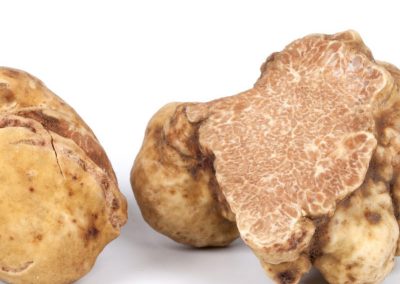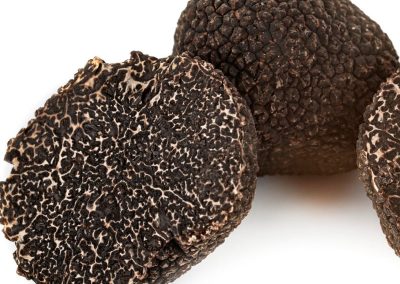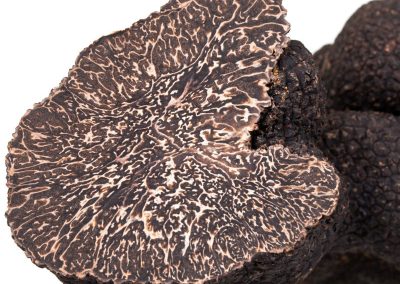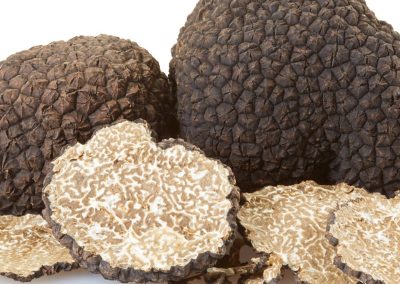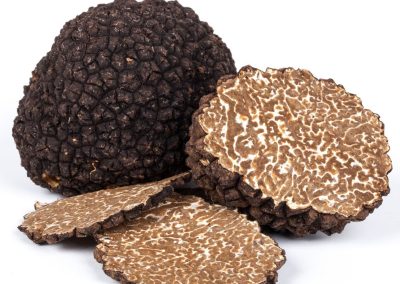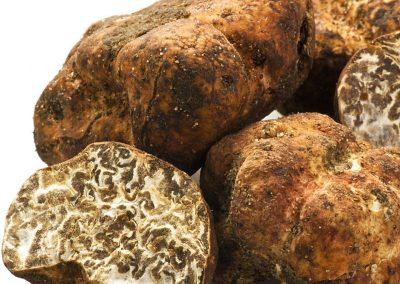
Truffle varieties
Truffles are a type of mushroom. The genus of the real truffles (lat. Tuber) belongs to the class of tubular mushrooms. However, by far not all truffle species are valuable for cooking. We have compiled the most common truffle varieties that are used as edible mushrooms - from the popular black summer truffle to the queen of truffles, the white Alba.
WHAT ARE TRUFFLES?
The truffle enjoys an excellent reputation among chefs and gourmets. Sometimes it is even called the diamond of the kitchen. Truffles are among the fungi that are not plants but form their own kingdom because they cannot photosynthesise. The genus of real truffles, Latin: tuber, belongs to the group of tubular mushrooms. In contrast to this are the cap mushrooms or mushrooms with kitchen classics such as chanterelles or mushrooms. Of the approximately 90 species of real truffles, only eight to ten play a role in the kitchen. Strictly speaking, it is not the mushroom that ends up in the kitchen, but its fruiting body. A mushroom is the huge, underground network of threads, some of them several kilometres long, that connects to the roots of its host plants.
WHERE DO TRUFFLES GROW?
The truffle mushrooms usually connect with the roots of deciduous trees. Very often they grow under oaks or hazels. However, they can also be found under beech trees, poplars, willows and lime trees. Both sides benefit from the association: The truffle supplies the tree with nitrogen, water and minerals such as magnesium and phosphorus. In return, the tree supplies the fungus with carbohydrates and vitamins. During reproduction, male and female spores "mate" and form fruiting bodies that also grow under the ground. They are suitable for culinary processing from about the size of a walnut. Larger truffles with the circumference of a fist are particularly sought after. In the natural environment, the growth process takes several decades. But truffle farmers specifically infect the roots, reducing the time to maturity to five to ten years.
HOW DO YOU FIND TRUFFLES?
Truffles can hardly be found with the eyes alone, as they grow several centimetres below the ground. To find the subterranean tubers, you need tools. In the past, truffle farmers used pigs to sniff out the intense scent of truffles, as it resembles the sexual scent of a boar. The beguiling smell attracts the female pigs so much that they often damage or eat the fruit while digging. Italy therefore banned the use of truffle pigs in the search as early as 1982. Nowadays, truffle farmers therefore rely on truffle dogs, which they train especially for the search. Hunting dogs are characterised by their excellent sense of smell anyway. At the "Universita dei Cani da Tartufo" in Piedmont, the Italian breed of Lagotto Romagnolo has been trained as a truffle dog since 1934. The basic training lasts 20 days, the professional programme three to four years.
HOW DO YOU CLEAN TRUFFLES?
In general, we recommend putting the truffles in an airtight container or a jar with a screw cap and storing them at 3°C in the refrigerator. Alternatively, you can wrap them in a damp cloth and place them in the vegetable compartment of the fridge for a few days. Before you prepare the truffles and cook them, for example, you should take them out of the refrigerator for a few hours. As truffles quickly lose their flavour and aroma, you should only process them towards the end of food preparation. First remove coarse clumps of soil and residues on the surface with a pointed knife. Then gently brush off any remaining dirt from the skin of the whole truffle. A vegetable brush or an unused toothbrush can be used for this. Be careful not to damage the skin of the truffle. Finally, shave or slice the mushroom into the dish. Under no circumstances should you rinse the truffles with water! As with other (high-quality) mushrooms, the truffle becomes watered down and loses its fine aroma as soon as it is treated with water. Rather take a few minutes more and clean the mushrooms thoroughly by hand. If a few pieces are left over from cooking, they end up in the fridge again - and not in the organic waste. Wrapped in a damp cloth, you can store the truffles again for a day or two.

